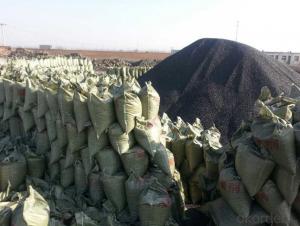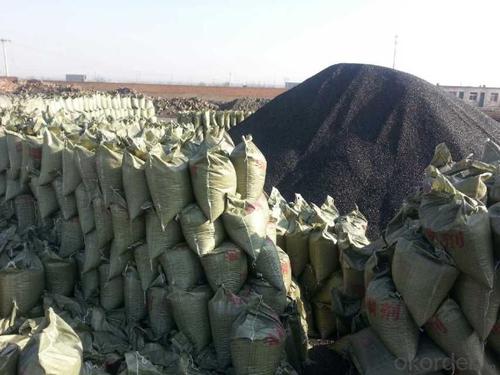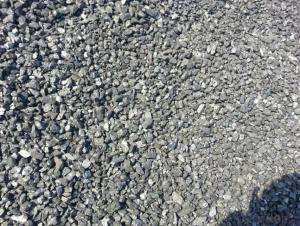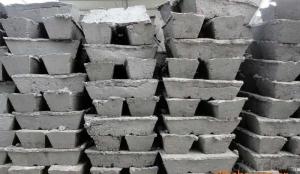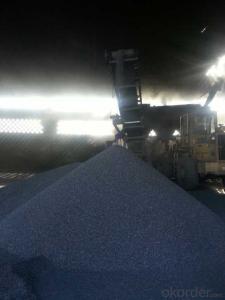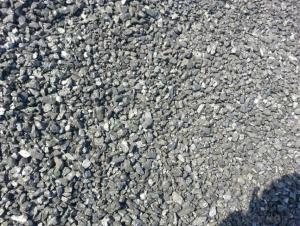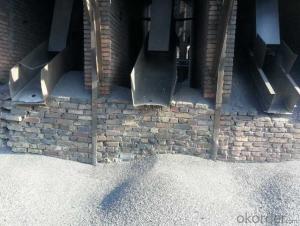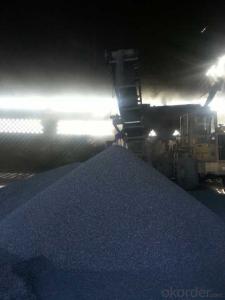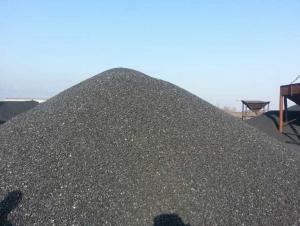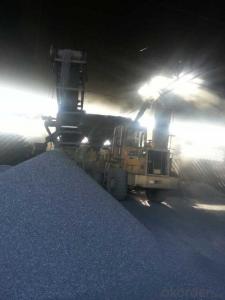FC93 Injection Carbon with good and stable quality
- Loading Port:
- Tianjin
- Payment Terms:
- TT OR LC
- Min Order Qty:
- 20 m.t.
- Supply Capability:
- 3000 m.t./month
OKorder Service Pledge
OKorder Financial Service
You Might Also Like
Specifications
Calcined Anthracite
1.low sulphur, low ash
2.fixed carbon:95% -90%
3.sulphur:lower than 0.3%
4.Calcined Anthracite Coal
Advantage and competitive of caclined anthracite:
1. strong supply capability
2. fast transportation
3. lower and reasonable price for your reference
4.low sulphur, low ash
5.fixed carbon:95% -90%
6..sulphur:lower than 0.3%
Package: In 25KG bags or in MT bags
Cardon additives made from well-selected Tai Xi anthracite .Mainly used in steelmaking
in electrical stove, screening water,quality,shipbuilding sandblast removing rust producingcarbon materials.Mainly industry property of it is : instead of traditional pertroleum coal of Carbon Additives,reduce the cost of steelmaking.
General Specification of Calcined Anthracite coal:
PARAMETER UNIT GUARANTEE VALUE
F.C.% 95MIN 94MIN 93MIN 92MIN 90MIN
ASH % 4MAX 5MAX6 MAX6.5MAX8.5MAX
V.M.% 1 MAX 1MAX1.0MAX1.5MAX 1.5MAX
SULFUR % 0.3MAX0.3MAX0.3MAX0.35MAX0.35MAX
MOISTURE %0.5MAX0.5MAX0.5MAX0.5MAX0.5MAX
Pictures:
| FC % | 95 | 94 | 93 | 92 | 90 |
| ASH % | 4 | 5 | 6 | 6.5 | 8.5 |
| V.M. % | 1 | 1 | 1 | 1.5 | 1.5 |
| S % | 0.3 | 0.3 | 0.3 | 0.35 | 0.35 |
| MOISTURE % | 0.5 | 0.5 | 0.5 | 0.5 | 0.5 |
Pictures
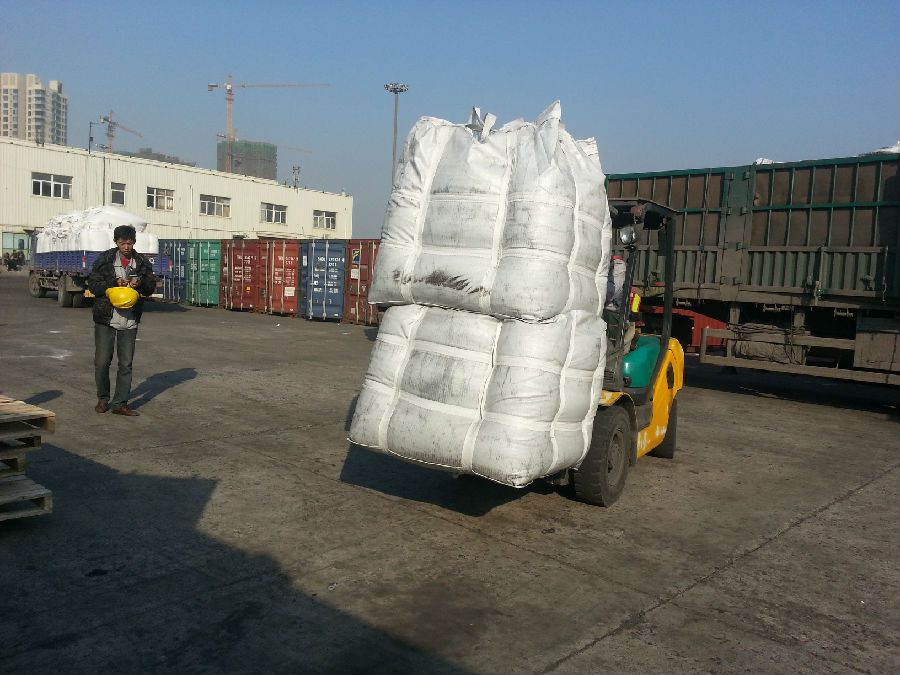
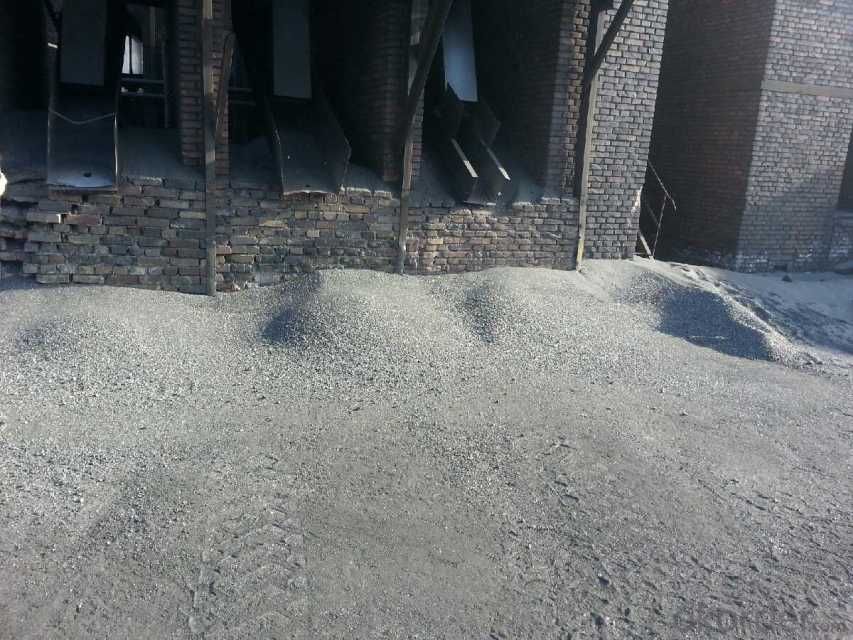
- Q: What is carbon offsetting in aviation?
- The aviation industry utilizes carbon offsetting as a mechanism to counterbalance the carbon emissions it generates. Since airplanes contribute significantly to greenhouse gas emissions, carbon offsetting offers a means for airlines and passengers to acknowledge their carbon footprint and contribute to the battle against climate change. The carbon offsetting process involves calculating the quantity of carbon dioxide and other greenhouse gases released during a flight, and subsequently investing in projects that decrease an equal amount of emissions elsewhere. These projects may encompass initiatives involving renewable energy, forest preservation, or methane capture. The objective is for the emissions reduced or eliminated by these projects to compensate for the emissions produced by the aviation industry. To partake in carbon offsetting, airlines or passengers can acquire carbon offsets, which essentially represent credits equivalent to the reduction or elimination of one metric ton of carbon dioxide or its equivalent. These offsets are generated by certified projects that adhere to stringent standards and undergo independent verification. By investing in carbon offsets, the aviation industry can contribute to global endeavors aimed at reducing greenhouse gas emissions and mitigating the impact of air travel on climate change. It enables airlines and passengers to promptly take action to counteract the environmental repercussions of flying, as the reduction or elimination of emissions from offset projects helps to balance out the emissions generated by air travel. It is crucial to note that carbon offsetting in aviation should not serve as a means to justify or neglect the necessity of long-term solutions to reduce emissions from aircraft. Instead, it should be regarded as a supplementary measure to other strategies, such as investing in more fuel-efficient aircraft, utilizing sustainable aviation fuels, and implementing operational improvements. Nonetheless, carbon offsetting does provide a valuable tool to mitigate emissions in the short term, while the aviation industry endeavors to adopt more sustainable practices.
- Q: What are the effects of carbon emissions on the Earth's temperature?
- The Earth's temperature is significantly impacted by carbon emissions, particularly carbon dioxide (CO2), which is due to the greenhouse effect. The greenhouse effect is when certain gases in the Earth's atmosphere trap heat from the sun and prevent it from escaping into space, thus causing the planet to warm. When carbon emissions are released into the atmosphere, they act like a blanket, trapping more heat and making the greenhouse effect worse. This results in global temperatures increasing, commonly known as global warming. The main source of carbon emissions is the burning of fossil fuels such as coal, oil, and natural gas for energy production, transportation, and industrial processes. The accumulation of carbon dioxide and other greenhouse gases in the atmosphere has led to a steady rise in global temperatures over the past century. This temperature increase has various consequences for the Earth's climate system and ecosystems. One immediate impact of increased carbon emissions and global warming is the melting of polar ice caps and glaciers. As temperatures rise, ice melts at a faster rate, causing sea levels to rise. This poses a significant threat to coastal areas, with increased flooding and erosion potentially displacing communities and destroying habitats for different species. Moreover, global warming disrupts weather patterns, resulting in more frequent and severe extreme weather events. Heatwaves, droughts, hurricanes, and heavy rainfall become more common, causing damage to infrastructure, agriculture, and human health. Changes in precipitation patterns also affect water availability, potentially leading to water scarcity in certain regions. The Earth's temperature directly affects ecosystems and biodiversity. Many species are highly sensitive to even slight temperature changes, which can disrupt their natural habitats, alter migration patterns, and impact reproductive cycles. These changes can ultimately lead to the extinction of certain species and disrupt entire ecosystems. Furthermore, the warming of the Earth's temperature can have cascading effects on various natural processes. For example, it can cause the release of additional greenhouse gases from melting permafrost and the degradation of forests, further worsening global warming. In conclusion, the impact of carbon emissions on the Earth's temperature is significant and far-reaching. Global warming caused by increased carbon dioxide levels leads to the melting of ice caps, rising sea levels, extreme weather events, disruptions to ecosystems, and potential loss of biodiversity. Addressing carbon emissions and working towards sustainable practices are essential in mitigating these effects and ensuring a stable and livable planet for future generations.
- Q: How does carbon affect the formation of tornadoes?
- Carbon does not have a direct effect on tornado formation. Tornadoes primarily occur when warm, moist air from the surface interacts with cold, dry air from higher levels of the atmosphere, creating strong upward drafts and rotating air columns. Carbon, as an element, does not have a significant role in this process. However, carbon emissions and human-induced climate change can indirectly impact weather patterns, including the frequency and intensity of tornadoes. The burning of fossil fuels, which releases carbon dioxide into the atmosphere, contributes to global warming. This, in turn, leads to changes in temperature and moisture patterns that can influence the conditions necessary for tornado formation. The increased levels of carbon dioxide in the atmosphere can cause the atmosphere to become more unstable, creating conditions favorable for severe thunderstorms that can produce tornadoes. Moreover, the warmer atmosphere with higher moisture content can provide more fuel for these storms, potentially making them stronger. It is important to note that the relationship between carbon emissions and tornadoes is complex and still an ongoing area of research. While there is a possibility of a connection between climate change and tornadoes, it is difficult to attribute individual tornadoes solely to carbon emissions, as tornadoes are influenced by various meteorological factors. In conclusion, carbon does not directly impact tornado formation, but the increased carbon emissions and resulting climate change can indirectly affect the conditions that contribute to tornado formation. Further scientific research is necessary to fully comprehend the relationship between carbon emissions, climate change, and tornado activity.
- Q: What are carbon nanotubes?
- Carbon nanotubes are cylindrical structures made entirely of carbon atoms arranged in a unique way. They have a diameter of only a few nanometers, hence the name "nanotubes". These tubes can be incredibly long, with lengths that can reach up to several centimeters. Carbon nanotubes possess extraordinary properties due to their unique structure. They are incredibly strong and have excellent mechanical properties, being about 100 times stronger than steel at one-sixth of the weight. Additionally, they have exceptional thermal and electrical conductivity. These nanotubes can be categorized into two main types: single-walled carbon nanotubes (SWCNTs) and multi-walled carbon nanotubes (MWCNTs). The single-walled nanotubes consist of a single layer of carbon atoms rolled into a tube, while multi-walled nanotubes consist of multiple layers of these tubes nested within each other. Carbon nanotubes find applications in various fields due to their exceptional properties. In electronics, they are used as transistors and interconnects due to their high electrical conductivity. They are also utilized in energy storage devices, such as batteries and supercapacitors, due to their high surface area and high electrical conductivity. In materials science, carbon nanotubes are used to reinforce composites, making them stronger and lighter. They also have potential applications in medicine, as drug delivery systems and as imaging agents. Research is ongoing to further understand and harness the potential of carbon nanotubes. However, challenges remain in terms of their large-scale production, cost-effectiveness, and potential health and environmental concerns. Overall, carbon nanotubes represent an exciting and promising area of nanotechnology with vast potential for advancements in various fields.
- Q: What is the greenhouse effect?
- The greenhouse effect is a natural process that occurs when certain gases in the Earth's atmosphere trap heat from the sun and prevent it from escaping back into space. These gases, such as carbon dioxide (CO2), methane (CH4), and water vapor, act like a blanket, allowing sunlight to pass through but trapping the heat that is radiated back from the Earth's surface. This process is essential for the Earth's survival as it helps to maintain a relatively stable and habitable temperature range. Without the greenhouse effect, the Earth's average temperature would be much colder, making it uninhabitable for most life forms. However, human activities, such as burning fossil fuels, deforestation, and industrial processes, have significantly increased the concentration of greenhouse gases in the atmosphere. This excess of greenhouse gases intensifies the greenhouse effect, leading to a phenomenon known as global warming. Global warming refers to the gradual increase in the Earth's average temperature, primarily caused by human-induced greenhouse gas emissions. This rise in temperature has far-reaching consequences, including melting ice caps, rising sea levels, extreme weather events, and disruption of ecosystems. The greenhouse effect itself is a natural and necessary process, but the enhanced greenhouse effect caused by human activities is contributing to climate change. Therefore, it is crucial to reduce greenhouse gas emissions and adopt sustainable practices to mitigate the adverse effects of global warming.
- Q: What are the environmental impacts of burning fossil fuels?
- Burning fossil fuels has significant environmental impacts that contribute to climate change and air pollution. When fossil fuels such as coal, oil, and natural gas are burned, they release greenhouse gases, primarily carbon dioxide (CO2), into the atmosphere. These greenhouse gases trap heat, causing global warming and climate change. The increased concentration of CO2 in the atmosphere is the main driver of global warming, leading to rising temperatures and shifts in weather patterns. This, in turn, results in more frequent and severe natural disasters like hurricanes, droughts, and floods. The melting of polar ice caps and glaciers is also accelerated, leading to rising sea levels, which pose a threat to coastal communities and ecosystems. In addition to climate change, burning fossil fuels releases other harmful air pollutants, such as nitrogen oxides (NOx) and sulfur dioxide (SO2). These pollutants contribute to the formation of smog and acid rain, which have detrimental effects on human health, agriculture, and ecosystems. Furthermore, the extraction and transportation of fossil fuels cause environmental degradation. Activities like mining for coal or drilling for oil can lead to deforestation, habitat destruction, and soil and water pollution. Oil spills from offshore drilling operations have devastating consequences for marine life and ecosystems, as witnessed in incidents like the Deepwater Horizon disaster in the Gulf of Mexico. Overall, the environmental impacts of burning fossil fuels are far-reaching and severe. Transitioning to cleaner and renewable energy sources is crucial to mitigate climate change, reduce air pollution, and safeguard our planet for future generations.
- Q: What is carbon steel, carbon manganese steel?
- Carbon manganese steel is a high-quality carbon structural steel in the higher manganese content of carbon steel, manganese elements are generally marked in the rear, such as 20Mn, 40Mn and so on
- Q: What role does carbon play in photosynthesis?
- Carbon plays a crucial role in photosynthesis as it is the primary building block for organic molecules. During photosynthesis, carbon dioxide is taken in by plants and converted into glucose, a simple sugar, using energy from sunlight. This glucose is then used to synthesize more complex carbohydrates, such as starch, cellulose, and other organic molecules, which are essential for plant growth and development.
- Q: How is carbon used in the production of construction materials?
- Carbon is used in the production of construction materials in several ways. One of the most common applications is in the production of steel, which is a vital material in the construction industry. Carbon is a key component in the iron and steel-making process, as it is combined with iron to create a stronger and more durable material. The addition of carbon to iron forms a compound known as steel, which has excellent structural properties and can be used to construct various components of buildings, such as beams, columns, and reinforcement bars. Additionally, carbon fibers are increasingly being used in the production of construction materials. Carbon fibers are lightweight, yet incredibly strong and stiff, making them ideal for reinforcing concrete and other materials. When carbon fibers are added to concrete, they enhance its strength and durability by reducing cracking and improving its resistance to impact and corrosion. This allows for the construction of structures that are more resilient and longer-lasting. Furthermore, carbon is used in the production of composite materials, which are becoming popular in construction. Carbon composites are made by combining carbon fibers with a polymer matrix, resulting in a material that is lightweight, yet strong and rigid. These composites are used in various construction applications, such as building panels, roofing, and bridges, as they offer high strength-to-weight ratios and excellent resistance to environmental factors. In summary, carbon plays a crucial role in the production of construction materials. It is used in the creation of steel, which is a fundamental component of buildings, and its fibers are employed to reinforce concrete and other materials. Additionally, carbon composites provide lightweight and high-strength solutions for construction applications. By harnessing the properties of carbon, construction materials can be made stronger, more durable, and more sustainable.
- Q: How is carbon used in water filtration systems?
- Due to its impressive adsorption properties, carbon is widely used in water filtration systems. Adsorption occurs when the molecules of a substance bind to the surface of another material, which is the case with carbon in this context. In water filtration, activated carbon is particularly effective. It is carbon that has undergone special processing to create a large surface area. When water passes through the filtration system, the carbon captures and retains various impurities, including organic compounds, chlorine, volatile organic compounds (VOCs), and certain heavy metals. This adsorption process effectively eliminates unpleasant odors and tastes, making the water more enjoyable to drink. Furthermore, carbon plays a crucial role in removing potentially harmful contaminants such as pesticides, herbicides, and pharmaceutical residues. Additionally, carbon filtration systems aid in reducing the risk of waterborne illnesses by eliminating bacteria, viruses, and parasites. In summary, carbon is an indispensable element of water filtration systems as it greatly enhances the quality and safety of drinking water.
Send your message to us
FC93 Injection Carbon with good and stable quality
- Loading Port:
- Tianjin
- Payment Terms:
- TT OR LC
- Min Order Qty:
- 20 m.t.
- Supply Capability:
- 3000 m.t./month
OKorder Service Pledge
OKorder Financial Service
Similar products
Hot products
Hot Searches
